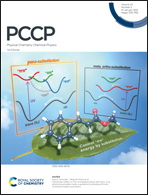Disintegration of excitons in π-conjugated molecules
Abstract
Utilizing the exact diagonalization (ED) method, we find that excitons cannot form in π-conjugated molecules such as anthracene, phenanthrene, and pyrene when the electron–electron interaction is governed by the Rytova–Keldysh (RK) potential. Within the Pariser–Parr–Pople (PPP) model, however, the excitons may survive only in the presence of a weak screening effect. Either way, the optical gap is seen to be insensitive to the dielectric environment owing to the opposite contributions from the excitonic effect and quasiparticle correction. Furthermore, the latter two are shown to exhibit almost the same behavior in all three molecules when the screening parameter varies.



 Please wait while we load your content...
Please wait while we load your content...